
The Vital Role of Mechanics in Advancing Renewable Energy Technologies
Takeaways: Mechanics is essential in the design, efficiency, and operation of renewable energy technologies such as wind turbines, solar panels, and hydropower systems. Understanding mechanical principles leads to improved performance, sustainability, and cost-effectiveness in energy generation.
As the world shifts towards sustainable energy sources, the importance of mechanics in renewable energy technologies cannot be overstated. Mechanics, the branch of physics dealing with the behavior of physical bodies under the influence of forces, plays a pivotal role in the functionality and efficiency of renewable energy systems. This article delves into the various ways mechanics influences renewable energy technologies, highlighting its significance and applications in the field.
1. Mechanics in Wind Energy Technologies

The rotor blades of a wind turbine are designed using aerodynamic principles, which are governed by mechanics. The shape, size, and material of the blades affect their efficiency in capturing wind energy. Mechanics helps engineers optimize these parameters to ensure maximum energy conversion. Additionally, the gearbox and generator systems are mechanical components that convert the rotational energy generated by the blades into usable electricity. The efficiency of these components is crucial for the overall performance of the wind energy system.
Moreover, the mechanical stability of wind turbines is essential for their longevity and reliability. Mechanics determines how turbines withstand various forces, such as gusts of wind and gravitational forces. Proper mechanical design ensures that wind turbines can operate efficiently over their lifespan, minimizing maintenance costs and maximizing energy output.
2. The Role of Mechanics in Solar Energy Systems

In photovoltaic systems, the angle of the solar panels can significantly influence their energy output. Mechanics is applied to determine the optimal tilt and orientation to maximize exposure to sunlight throughout the day and across seasons. This optimization requires an understanding of mechanical principles such as torque and load distribution.
Furthermore, in solar thermal systems, mechanics is involved in the design of heat exchangers and piping systems that transport heat efficiently. The mechanical design of these components ensures minimal energy loss and effective heat transfer, which is crucial for the efficiency of solar thermal energy generation.
3. Mechanics in Hydropower Systems

Understanding fluid mechanics is essential in hydropower, as it governs the behavior of water flow and its interaction with turbine blades. Engineers apply these principles to design turbines that can maximize energy extraction from water while minimizing environmental impacts.
Additionally, the mechanical integrity of dams and associated structures is crucial for safety and efficiency. Mechanics is used to analyze stress distributions and ensure that these structures can withstand the forces of water and earth, preventing failures that could lead to catastrophic consequences.
Conclusion

